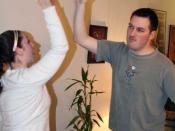Humans rely on speech every day because it is an integral part of our civilization. From a philosopherÃÂs standpoint, one could say that our ability to communicate verbally is part of what makes us human. What, then, would the philosopher say about those who are incapable of verbal communication? This is the plight of those who either have severe difficulty with speech or altogether lack the ability to speak due to autism. For autistic individuals, this is their reality: a world with limited, and sometimes completely devoid of, vocabulary. Autism is a fairly common condition that affects about 5 in 10,000 individuals (Piven, 1997), and with it comes the language deficit that partially defines the condition itself. Difficulties with language use and acquisition are two prominent symptoms of autism, and there may also be issues with nonverbal communication. These difficulties in turn lead to problems with social interactions. Research has suggested a number of brain irregularities that are responsible for the language deficits, and although the irregularities cannot be corrected, some progress has been made in designing methods that can be used to aid in language acquisition.
Language deficits are the most variable aspect of autism spectrum disorders (ASD). Some autistic individuals can develop a somewhat functional vocabulary and some language fluency. These people can express themselves and their thoughts, although slowly and with varying degrees of difficulty. Speech impediments, such as lisps, are common. Conversely, some autistic people will never speak, and instead rely solely on nonverbal communication. Some nonverbal autistic individuals express themselves in other ways, including mathematical, artistic, or musical savantism. No one knows why language use has such a broad range of severity in ASD, but there are ways to estimate an autistic individualÃÂs future language potential. Timing is an important factor when...


